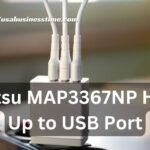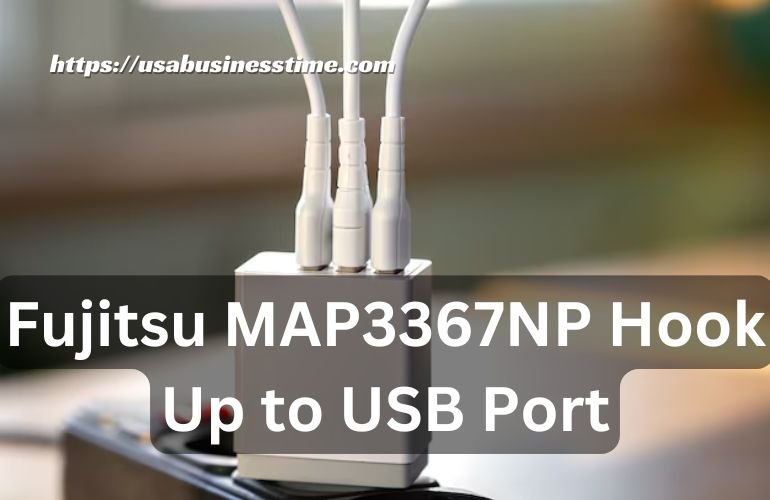Connecting legacy hardware like the Fujitsu MAP3367NP Hook Up to USB Port to modern USB ports can seem challenging but is achievable with the right tools and guidance. This guide simplifies the process, covering everything from necessary equipment to troubleshooting tips. Whether you’re looking to access old data or repurpose the drive, this article will help you get started and maintain a reliable connection.
Table of Contents
Necessary Tools and Preparation
Before connecting the Fujitsu MAP3367NP to a USB port, having the right tools and preparation is key to a smooth process. Here’s what you’ll need:

- USB-to-SCSI Adapter
The Fujitsu MAP3367NP uses the SCSI interface, so a USB-to-SCSI adapter is required to bridge the connection between the hard drive and your computer’s USB port. Choose an adapter that supports the specific type of SCSI interface your drive uses (e.g., 50-pin, 68-pin). Make sure the adapter is compatible with your operating system for smooth data transfer. - SCSI Controller Card (if needed)
In some cases, a SCSI controller card might be necessary, especially if your computer doesn’t support direct SCSI connections. The card allows you to connect the SCSI drive to your computer, acting as an intermediary between the drive and the USB port. - Cables
You will need the appropriate cables to connect the USB-to-SCSI adapter to the drive and the computer. A SCSI cable that matches the adapter’s port is required to link the Fujitsu MAP3367NP to the adapter. Make sure the cables are in good condition to avoid connectivity issues. - Power Supply
The Fujitsu MAP3367NP requires an external power source. Depending on the model, this may be a separate power adapter or a power cable that connects to the drive. Make sure the power supply is working properly and can handle the drive’s power requirements. - Software and Drivers
For the connection to work seamlessly, you may need to install drivers for the USB-to-SCSI adapter. Check the manufacturer’s website for the latest drivers compatible with your operating system. Additionally, you may need software for managing the data on the drive, especially if it’s formatted in a legacy file system. - Preparing the Drive
Before connecting, check the condition of the Fujitsu MAP3367NP. If it has been unused for a while, make sure it is free of dust and debris. If necessary, clean the connectors gently to avoid poor connections. Make sure the drive is powered off before making any connections.
With these tools and preparations in place, you’ll be ready to connect the Fujitsu MAP3367NP to a USB port with minimal hassle.
Step-by-Step Guide to Connecting the Fujitsu MAP3367NP Hook Up to USB Port
Once you have all the necessary tools and preparations in place, follow these steps to successfully connect the Fujitsu MAP3367NP to your USB port:
- Prepare the Fujitsu MAP3367NP and Adapters
Start by ensuring the Fujitsu MAP3367NP is powered off. Connect the SCSI cable to the hard drive’s SCSI port and the USB-to-SCSI adapter. Make sure the connections are secure and there are no loose cables. If your adapter has a separate power input, connect the power cable to the drive and plug it into a power source. - Connect the Adapter to the USB Port
Once the drive and adapter are connected, plug the USB end of the adapter into an available USB port on your computer. Choose a USB 3.0 or higher port for faster data transfer speeds, if available. - Power Up the Fujitsu MAP3367NP
Turn on the Fujitsu MAP3367NP. The drive should begin to power up, and the adapter will establish the connection with the computer. Wait for the computer to recognize the drive. This may take a few moments, especially if drivers need to be installed. - Install Necessary Drivers
If your computer doesn’t automatically detect the drive, check if the USB-to-SCSI adapter requires specific drivers. Install any necessary drivers from the adapter manufacturer’s website or the included installation disc. Follow the on-screen instructions to complete the installation. - Check Device Recognition
After the drivers are installed, check your computer’s device manager or file explorer to confirm the drive is recognized. On Windows, you can open “This PC” or “Disk Management” to see if the Fujitsu MAP3367NP appears as an external drive. On Mac, check Finder or Disk Utility. - Format the Drive (if needed)
If the drive is not formatted or is in an incompatible file system, you may need to format it. Be aware that formatting will erase all data on the drive, so back up any important files beforehand. Choose a file system compatible with your operating system, such as NTFS for Windows or HFS+ for Mac. - Access and Use the Drive
Once the drive is successfully connected and formatted, you can start accessing the data stored on the Fujitsu MAP3367NP. You can copy, move, or manage files as needed.
By following these steps, you can easily connect the Fujitsu MAP3367NP to your USB port and start using it as an external storage device.
Troubleshooting and Common Issues
While connecting the Fujitsu MAP3367NP to a USB port is straightforward, you may encounter some issues along the way. Here are some common problems and their solutions:
- Drive Not Recognized by the Computer
If your computer doesn’t recognize the Fujitsu MAP3367NP after connecting it, try the following steps:- Check the connections: Ensure that all cables are securely connected, including the USB-to-SCSI adapter and power supply.
- Test the USB port: Plug the adapter into a different USB port on your computer to rule out a faulty port.
- Reboot the computer: Sometimes, a simple restart can help the system detect the connected device.
- Install or update drivers: If the drive isn’t recognized, ensure that the necessary drivers for the USB-to-SCSI adapter are installed. Check the manufacturer’s website for the latest version.
- Slow Data Transfer Speeds
If the data transfer speed is slower than expected, consider these factors:- USB port version: Make sure you’re using a USB 3.0 or higher port for faster speeds. Older USB 2.0 ports can significantly slow down the transfer rate.
- Cable quality: A damaged or low-quality cable can cause slower transfer speeds. Try using a different USB cable or a higher-quality one if possible.
- Drive condition: If the Fujitsu MAP3367NP is an older drive, its performance may naturally be slower compared to modern drives.
- Power Issues
If the drive is not powering up, check the following:- Power supply: Make sure the power cable is securely connected to both the drive and the power source. If the drive requires an external power adapter, confirm that it is plugged in properly and working.
- Check the adapter: Some USB-to-SCSI adapters may require an additional power supply. If this is the case, ensure that the adapter is receiving power from the source.
- Driver or Compatibility Issues
If the device is not functioning correctly after installation, there may be a compatibility issue:- Check operating system compatibility: Make sure the drivers for the USB-to-SCSI adapter are compatible with your operating system. If not, try to find alternative drivers or update your system.
- Use a different adapter: If you suspect the USB-to-SCSI adapter is faulty, try using a different one to see if the issue persists.
- File System Issues
If the drive is not showing up in your file explorer or is inaccessible, it may be due to a file system issue:- Reformat the drive: If the drive is not formatted or is in an unsupported file system, you may need to reformat it. Be aware that reformatting will erase all data on the drive, so back up any important files before proceeding.
- Device Disconnects During Use
If the drive keeps disconnecting or losing connection:- Check cable integrity: Ensure that the USB cable and SCSI connection are in good condition and securely attached.
- Test with another computer: If the problem persists, try connecting the drive to another computer to rule out issues with the USB port or drivers.
By following these troubleshooting steps, you can resolve most common issues encountered when connecting the Fujitsu MAP3367NP to a USB port. If the problem persists, it may be necessary to consult the manufacturer’s support or consider using a professional data recovery service.
Maximizing Performance and Exploring Alternatives
Once your Fujitsu MAP3367NP is connected to the USB port and functioning correctly, there are several ways to maximize its performance and explore alternative solutions for data access.
- Improving Connection Stability
- Use high-quality cables: Low-quality or damaged cables can cause connectivity issues. Ensure you’re using reliable USB and SCSI cables to maintain a stable connection.
- Avoid power interruptions: If your drive is powered externally, ensure the power supply is consistent and reliable. Sudden power loss can cause data corruption or drive failure.
- Monitor USB port health: If you’re using an older USB port, consider upgrading to a newer version (USB 3.0 or higher) for faster and more stable data transfer speeds.
- Evaluating USB-to-SCSI Adapters
Not all USB-to-SCSI adapters perform equally. When choosing an adapter, keep these factors in mind:- Compatibility: Ensure the adapter is compatible with both the SCSI interface of the Fujitsu MAP3367NP and your computer’s operating system.
- Data transfer speed: Some adapters may limit the speed of data transfer. Choose an adapter that supports the highest transfer rates possible for your needs.
- Build quality: Look for adapters with good reviews regarding durability and performance, as poorly constructed adapters can cause frequent disconnections or data errors.
- Exploring Alternative Solutions for Data Access
If you experience limitations with the USB-to-SCSI connection or need additional functionality, consider the following alternatives:- SCSI-to-Ethernet adapters: For network-based access, a SCSI-to-Ethernet adapter allows you to connect the drive to a network and access it remotely, which can be useful for larger data management tasks.
- Upgrading to a modern storage solution: If the Fujitsu MAP3367NP is frequently used for large data transfers, upgrading to a more modern hard drive or SSD with native USB support may offer faster speeds and easier connectivity.
- Professional Data Recovery Services
In case of data loss or drive failure, it may be beneficial to consult professional data recovery services. These experts can recover data from damaged drives or handle situations where the drive is not recognized due to hardware failure. - Regular Maintenance and Updates
To prolong the life of your Fujitsu MAP3367NP and maintain consistent performance:- Perform regular backups: Always back up important data to avoid losing critical files.
- Check for firmware updates: Occasionally, firmware updates for the drive or USB-to-SCSI adapter can improve performance or resolve known issues.
- Clean the drive periodically: Dust and debris can interfere with the connections. Regularly clean the connectors and keep the drive in a cool, dry environment.
By following these steps, you can maximize the performance of your Fujitsu MAP3367NP and explore alternative solutions to improve data access and connectivity.
Final Thoughts
Connecting the Fujitsu MAP3367NP to a USB port provides a simple and effective way to access legacy data stored on older SCSI drives. By following the right steps, using compatible adapters, and troubleshooting common issues, you can successfully use this drive with modern systems.

While there may be some initial challenges, the process is manageable with the right tools and preparation. Additionally, alternatives such as SCSI-to-Ethernet adapters or upgrading to newer storage solutions can further improve performance and convenience. Regular maintenance and proper handling will help keep the drive running smoothly for years to come.
Whether you’re looking to recover old data or repurpose the Fujitsu MAP3367NP for other uses, this guide should help you achieve a stable and reliable connection to your USB port.
Conclusion
Connecting the Fujitsu MAP3367NP to a USB port is a practical solution for accessing data stored on older SCSI drives. By following the steps outlined in this guide, you can easily set up the connection, troubleshoot common issues, and maintain stable performance. If you encounter any difficulties, troubleshooting tips and alternative solutions can help resolve them. Whether you’re working with legacy data or upgrading your storage options, this process offers a reliable way to keep your Fujitsu MAP3367NP drive functional with modern systems.











